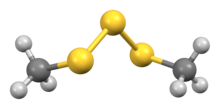 | |
 | |
| Names | |
|---|---|
| Preferred IUPAC name
Dimethyltrisulfane[1] | |
| Other names
2,3,4-trithiapentane
| |
| Identifiers | |
3D model (JSmol)
|
|
| ChEBI | |
| ChemSpider | |
| ECHA InfoCard | 100.020.828 |
| EC Number |
|
| KEGG | |
PubChem CID
|
|
| UNII | |
CompTox Dashboard (EPA)
|
|
| |
| |
| Properties | |
| C2H6S3 | |
| Molar mass | 126.26 g/mol |
| Density | 1.1978 g/cm3 |
| Melting point | −68.05 °C (−90.49 °F; 205.10 K) |
| Boiling point | 170 °C (338 °F; 443 K) (65–68 °C @ 25 Torr) |
Except where otherwise noted, data are given for materials in their standard state (at 25 °C [77 °F], 100 kPa).
| |
Dimethyl trisulfide (DMTS) is an organic chemical compound and the simplest organic trisulfide, with the chemical formula CH3SSSCH3.[2][3] It is a flammable liquid with a foul odor, which is detectable at levels as low as 1 part per trillion.[4]
Occurrence
[edit]Dimethyl trisulfide has been found in volatiles emitted from cooked onion, leek and other Allium species, from broccoli and cabbage, as well as from Limburger cheese,[5] and is involved in the unpalatable aroma of aged beer and stale Japanese sake.[6] It is a product of bacterial decomposition, including the early stages of human decomposition,[7] and is a major attractant for blowflies looking for hosts. Dimethyl trisulfide along with dimethyl sulfide and dimethyl disulfide have been confirmed as volatile compounds given off by the fly-attracting plant known as dead-horse arum (Helicodiceros muscivorus). These flies are attracted to the odor of fetid meat and help pollinate this plant.[8] DMTS contributes to the foul odor given off by the fungus Phallus impudicus, also known as the common stinkhorn. DMTS causes the characteristic malodorous smell of a fungating lesion, e.g., from cancer wounds,[4] and contributes to the odor of human feces.[9]
DMTS can be synthesized by the reaction of methanethiol with hydrogen sulfide (in the presence of copper (II))[10] and with sulfur dichloride,[11] among other methods:[3]
- 2 CH3SH + SCl2 → CH3SSSCH3 + 2 HCl
Chemical reactions
[edit]On heating at 80 °C, DMTS slowly decomposes to a mixture of dimethyl di-, tri-, and tetrasulfides.[11] The reactivity of DMTS is related to its weak sulfur-sulfur bond (ca. 45 kcal/mol).[2] Dimethyl tetrasulfide, which is thermally more reactive than dimethyl trisulfide, has a still weaker (central) sulfur-sulfur bond (ca. 36 kcal/mol).[11] Oxidation of DMTS by meta-chloroperoxybenzoic acid (mCPBA) gives the corresponding S-monoxide, CH3S(O)SSCH3.[12]
Uses
[edit]Trap baits containing dimethyl trisulfide have been used to capture Calliphora loewi and other blowflies.[13] Dimethyl trisulfide has been found to be an effective cyanide antidote in a rodent model for cyanide poisoning both against subcutaneous potassium cyanide and inhaled hydrogen cyanide, converting cyanide to much less toxic thiocyanate. It is suggested that dimethyl trisulfide can be used in a mass casualty cyanide exposure setting. In conjunction with these studies, the LD50 of dimethyl trisulfide in CD-1 mice was found to be 598.5 mg/kg, which may be compared to the LD50 of potassium cyanide of 8.0 mg/kg.[14]
References
[edit]- ^ IUPAC Chemical Nomenclature and Structure Representation Division (2013). "P-68.4.1.1". In Favre, Henri A.; Powell, Warren H. (eds.). Nomenclature of Organic Chemistry: IUPAC Recommendations and Preferred Names 2013. IUPAC–RSC. ISBN 978-0-85404-182-4.
- ^ a b Edward L. Clennan; Kristina L. Stensaas (1998). "Recent progress in the synthesis, properties and reactions of trisulfanes and their oxides". Organic Preparations and Procedures International. 30 (5): 551–600. doi:10.1080/00304949809355321.
- ^ a b Ralf Steudel (2002). "The Chemistry of Organic Polysulfanes R−Sn−R (n > 2)". Chemical Reviews. 102 (11): 3905–3945. doi:10.1021/cr010127m. PMID 12428982.
- ^ a b Shirasu, Mika; Nagai, Shunji; Hayashi, Ryuichi; Ochiai, Atsushi; Touhara, Kazushige (2009). "Dimethyl trisulfide as a characteristic odor associated with fungating cancer wounds". Bioscience, Biotechnology, and Biochemistry. 73 (9): 2117–20. doi:10.1271/bbb.90229. PMID 19734656. S2CID 28235413.
- ^ Thomas H. Parliament; Michael G. Kolor; Donald J. Rizzo (1982). "Volatile components of Limburger cheese". J. Agric. Food Chem. 30 (6): 1006–1008. doi:10.1021/jf00114a001.
- ^ Atsuko Isogai; Ryoko Kanda; Yoshikazu Hiraga; Toshihide Nishimura; Hiroshi Iwata; Nami Goto-Yamamoto (2009). "Screening and Identification of Precursor Compounds of Dimethyl Trisulfide (DMTS) in Japanese Sake". J. Agric. Food Chem. 57 (1): 189–195. doi:10.1021/jf802582p. PMID 19090758.
- ^ M. Statheropoulosa; A. Agapioua; C. Spiliopoulou; G.C. Pallis; E. Sianos (2007). "Environmental aspects of VOCs evolved in the early stages of human decomposition". Science of the Total Environment. 385 (1–3): 221–227. Bibcode:2007ScTEn.385..221S. doi:10.1016/j.scitotenv.2007.07.003. PMID 17669473.
- ^ Marcus C. Stensmyr; Isabella Urru; Ignazio Collu; Malin Celander; Bill S. Hansson; Anna-Maria Angioy (2002). "Rotting smell of dead-horse arum florets". Nature. 420 (6916): 625–626. Bibcode:2002Natur.420..625S. doi:10.1038/420625a. PMID 12478279. S2CID 1001475.
- ^ J.G. Moore; L.D. Jessop; D.N. Osborne, DN. (1987). "Gas-chromatographic and mass-spectrometric analysis of the odor of human feces". Gastroenterology. 93 (6): 1321–1329. doi:10.1016/0016-5085(87)90262-9. PMID 3678751.
- ^ Mustapha Nedjma; Norbert Hoffmann (1996). "Hydrogen Sulfide Reactivity with Thiols in the Presence of Copper(II) in Hydroalcoholic Solutions or Cognac Brandies: Formation of Symmetrical and Unsymmetrical Dialkyl Trisulfides". J. Agric. Food Chem. 44 (12): 3935–3938. doi:10.1021/jf9602582.
- ^ a b c Timothy L. Pickering; K. J. Saunders; Arthur V. Tobolsky (1967). "Disproportionation of organic polysulfides". J. Am. Chem. Soc. 89 (10): 2364–2367. doi:10.1021/ja00986a021.
- ^ J. Auger; Y. Koussourakos; E. Thibout (1985). "Monooxidation of organic trisulfides". Chimika Chronika. 14 (4): 263–264.
- ^ Nilssen Arne C.; Åge Tǿmmerås Bjǿrn; Schmid Rudolf; Barli Evensen Sissel (1996). "Dimethyl trisulphide is a strong attractant for some calliphorids and a muscid but not for the reindeer oestrids Hypoderma tarandi and Cephenemyia trompe". Entomologia Experimentalis et Applicata. 79 (2): 211–218. Bibcode:1996EEApp..79..211N. doi:10.1111/j.1570-7458.1996.tb00828.x. S2CID 86404109.
- ^ DeLeon, SM; et al. (2018). "DMTS is an effective treatment in both inhalation and injection models for cyanide poisoning using unanesthetized mice". Clinical Toxicology. 56 (25): 332–341. doi:10.1080/15563650.2017.1376749. PMC 6322672. PMID 28922956.